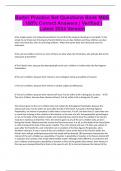Exam (elaborations)
Barbri Practice Set Questions Bank MBE 100% Correct Answers Verified Latest 2024 Version
- Course
- Institution
Barbri Practice Set Questions Bank MBE | 100% Correct Answers | Verified | Latest 2024 Version A fee simple owner of a restaurant provided in his will that the property should go on his death "in fee simple to my friend, but if during my friend's lifetime my son has children and those children ...
[Show more]



